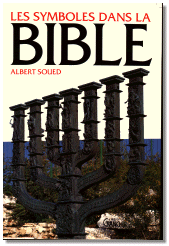 |
The seven-branched candelabra is the most known symbol in the hebrew iconography. Its manufacturing is minutely described in the Bible and it was used to adorn the southern side of the Sanctuary in the Meeting Tent and in the Temple of Jerusalem. Today a huge sculpture decorates a garden in Jerusalem. |
|
The Book during certain Jewish festivals, why one kindles two lights on the shabat eve, the meaning of the fish which swallows Jonas and that of the two cherubs above the arch in the sanctuary of the Temple of Jerusalem ; the meaning and the purpose of the ritual bath, of the wedding canopy (h’upah) or the ritual of the circumcision. The ritual is the transmitted custom, the gesture one repeats from one generation to another, losing gradually upon the time its essential meaning and reach. The ceremonial displays items, sounds, drawings or gestures which commemorate an ancient story, buried in one’s memory, a legend or myth all humanity shares. To enter the initiatory world of the Bible, one has to go back up the times and has to read the Book differently, as it was read in the beginning, through the symbolic way. The Kabbalah tradition teaches us that one has to peel the words like an onion, peeling after peeling, to understand them thoroughly. The way of the symbol leads one who searches to a better inside clarity, by the discovery of essential messages. It helps us travelling through the fragrant paths of the Tree of Life and wander through the symphony of words.  Short outlook conveys a message which is to-day ill-perceived, often ill-understood. Nevertheless it remains a wished and even desired message, the Book being sold by millions. The symbol is one of the keys which open the box containing the original message, the password permitting the entry in the world of signs, an item, a drawing, a plant or an animal, a letter or anything else palpable and tangible. Such a sign is an allegorical substitute to a more subtle or more abstract concept. The seven-branched candelabrum has an obvious meaning as an item which illuminates, a source of light. The candelabrum shape is similar to a tree, with a trunk and branches. Going further, if the candelabrum is reminiscent of a tree, it can be perceived in two directions, either the summit is above the branches or beneath the roots ; then the candelabrum evokes a link or a connection between the " Up " and the " Down ", one being the image of the other. One can go further on, comparing the candelabrum to a blossoming almond-tree, or to an olive-tree, or to a " Tree of Life "… Thus when one speaks about a palm-tree in the Bible, in reality one is dealing with law-enforced justice ; when one speaks about an olive-tree, one is implying the justice coming from the heart. Generally speaking, the tree appears like an image of the testifying Just. The Tree shelters a lot of events, it is a meeting point where people communicate, share opinions, scatter news, pray… The Tree is the spring and the eye of the Just (in hebrew tree is " e ‘ts ", a’yin tsade or the spring/eye of the Just)  |